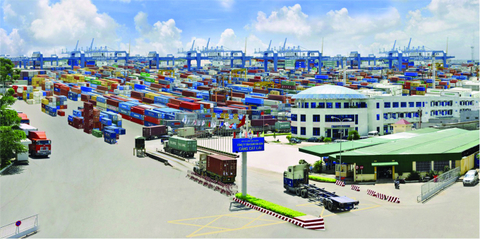
The Ministry of Transport plans to propose several seaport service charge increases. — Photo tapchigiaothong.vn
The Ministry of Transport is considering an increase to seaport service charges in a bid to attract more private logistics infrastructure investments.
Minister of Transport Nguyen Van Cong said many of Viet Nam’s seaport service fees remain lower than fees in the region’s other countries, making potential private investors hesitant to fund new seaport construction projects.
Cong used container loading and unloading charges as an example.
This fee is set at US$30 per container in Hai Phong, $45 in Da Nang and $41 in HCM City.
The same fee is $65 in Cambodia, $52 in Malaysia and $130 in Hong Kong.
“Loading and unloading fees must be raised to increase profits for operators,” Cong said. “Increased profits will lead to new investments and upgraded equipment that will improve service quality.”
Cong said passenger service fees should also be increased. The fee for each passenger is just $0.90-1.10, far lower than the $8 charged in Singapore and $14 in Hong Kong.
Cong pointed out that these low charges mean many of Viet Nam’s seaports run at a loss, making it difficult to attract private investors.
According to Trinh The Cuong of the Viet Nam Marine Administration, a proposal is being drafted to replace Ministry of Transport decree No 3863. The new draft will include two options for fee increases to bring the country closer to regional standards.
The first option would set passenger service charges between $2.50 and $5. Loading and unloading fees would see a 10 per cent rise, from $30 to $33 for 20-foot containers.
The second option would put passenger fees at a minimum of $5 and a maximum of $15. Loading charges would first rise 10 per cent in 2019 before seeing 10 per cent rises again in 2020 and 2030. This would bring loading fees to a final rate of $41 for 20-foot containers.
The ministry said it will submit the draft by the end of the month.
Representatives from Hai Phong, Da Nang and Chan May ports, meeting at a recent workshop, agreed passenger charges should increase to $15.
According to Cong, the higher fees would not translate to higher prices for consumers because the increases are already included in transport charges paid to logistics firms.
Cong also said it is necessary to improve transport infrastructure to reduce logistics costs. Viet Nam’s logistics costs remain high, accounting for 20.9 per cent of GDP. This is higher than China’s 19 per cent, Thailand’s 18 per cent and Japan’s 11 per cent.
Cong pointed out the underdeveloped nature of the country’s transport infrastructure. Viet Nam needs to connect production zones to seaports and airports, he said. In addition, the shortage of large-scale centres for circulating goods drives up logistics costs. — VNS